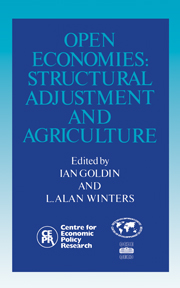Book contents
- Frontmatter
- Contents
- List of figures
- List of tables
- Preface
- Acknowledgements
- List of conference participants
- 1 Introduction: from macro to maize
- Part One Open economy analysis
- Part Two The small country assumption and trade reform
- 6 Exchange reforms, supply response, and inflation in Africa
- Discussion
- 7 Taxes versus quotas: the case of cocoa exports
- Discussion
- 8 Trade reform and the small country assumption
- Discussion
- Part Three Risk and adjustment
- Part Four Government's role
- Index
7 - Taxes versus quotas: the case of cocoa exports
from Part Two - The small country assumption and trade reform
Published online by Cambridge University Press: 04 August 2010
- Frontmatter
- Contents
- List of figures
- List of tables
- Preface
- Acknowledgements
- List of conference participants
- 1 Introduction: from macro to maize
- Part One Open economy analysis
- Part Two The small country assumption and trade reform
- 6 Exchange reforms, supply response, and inflation in Africa
- Discussion
- 7 Taxes versus quotas: the case of cocoa exports
- Discussion
- 8 Trade reform and the small country assumption
- Discussion
- Part Three Risk and adjustment
- Part Four Government's role
- Index
Summary
Introduction
This paper is part of an ongoing research effort aimed at analysing the interactions among commodity exports, real incomes and trade policies. We are particularly interested in evaluating the concern that efficiency or policy-induced changes in the supply of exports of primary commodities may lead to such a large decline in the prices of the latter that export revenues and incomes of the exporting countries actually decline. The commodities in question include cocoa, coffee, and tea.
The possibility of income and revenue loss arises principally because the world demand for primary commodities is relatively inelastic. The natural instrument the exporting countries can employ to counteract this problem is trade policy. In doing so, one must, however, recognize that since the exporting countries are neither small nor monopolies in the world markets, their policies are interdependent. Because the conventional trade models rely on one of these two extremes, they fail to capture the interdependence of policies central to the problem under consideration.
In our recent work, we have analysed in detail the implications of interdependence among countries when the policy instrument is an export tax. In Panagariya and Schiff (1991a), we derive Nash optimum taxes in a 10-country model of the world cocoa market. In our simulations, we find that compared to the initial equilibrium, tax competition implicit in Nash behaviour leads to a loss in real income for 8 out of 9 exporting countries. In Panagariya and Schiff (1991b), we compare income and revenue-maximizing Nash taxes. A key result in this paper is that under plausible circumstances, revenue-maximizing Nash taxes can yield higher levels of income than income-maximizing Nash taxes.
- Type
- Chapter
- Information
- Open EconomiesStructural Adjustment and Agriculture, pp. 150 - 169Publisher: Cambridge University PressPrint publication year: 1992
- 1
- Cited by

